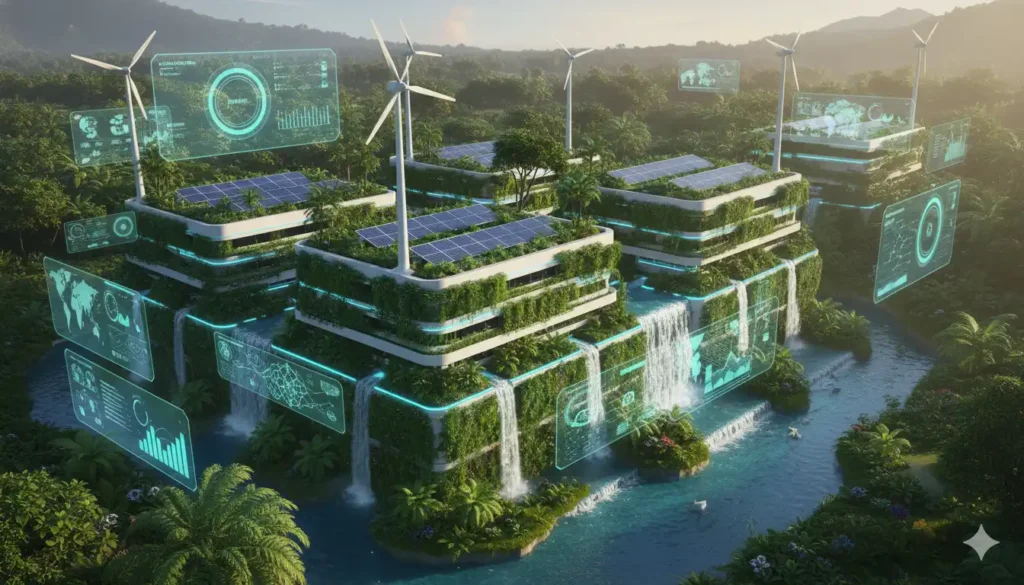Introduction
As climate change continues to shape the global agenda, technology companies are stepping up to embrace digital sustainability and green tech solutions. Once seen as part of the environmental problem due to high energy consumption and e-waste, the tech industry is now becoming a major driver of the sustainability revolution.
From renewable-powered data centers to eco-friendly hardware design and carbon-neutral supply chains, digital sustainability has become a core business strategy for forward-thinking firms. Let’s explore how tech giants—and startups alike—are going green to build a cleaner, smarter future.
What Is Digital Sustainability?
Digital sustainability refers to the responsible creation, use, and disposal of technology in a way that minimizes environmental impact and supports long-term ecological balance. It involves:
-
Reducing carbon emissions from data centers, devices, and supply chains.
-
Optimizing energy efficiency through smart infrastructure and cloud computing.
-
Promoting circular economy practices such as recycling and reusing electronic components.
-
Leveraging AI and IoT to monitor, manage, and reduce resource waste.
In essence, digital sustainability ensures that technology development aligns with environmental stewardship and corporate responsibility.
Why Green Tech Matters More Than Ever
Technology has transformed our lives—but it also consumes enormous energy. Data centers alone account for roughly 1–2% of global electricity use. Additionally, e-waste is the fastest-growing waste stream in the world, with over 50 million tons generated annually.
This growing environmental footprint has pressured tech firms to find greener alternatives. Green technology (or green tech) focuses on innovations that conserve energy, reduce pollution, and promote sustainability across industries.
The benefits of going green are not just ethical—they’re strategic:
-
Cost savings: Energy-efficient operations lower expenses.
-
Brand reputation: Eco-friendly practices boost consumer trust.
-
Compliance: Governments worldwide are enforcing strict carbon regulations.
-
Innovation: Sustainable R&D drives new market opportunities.
How Tech Firms Are Going Eco-Friendly
Let’s look at how major technology players are implementing sustainability at scale.
1. Renewable Energy-Powered Data Centers
Companies like Google, Microsoft, and Amazon Web Services (AWS) are leading the green energy transition.
-
Google has achieved 100% renewable energy matching since 2017, meaning it offsets all electricity consumption with clean energy purchases.
-
Microsoft aims to be carbon negative by 2030, removing more carbon than it emits.
-
AWS plans to power all data centers with renewable energy by 2025.
These initiatives reduce the carbon footprint of cloud computing—one of the biggest contributors to digital emissions.
2. Eco-Friendly Hardware and Product Design
Tech firms are also innovating at the product level:
-
Apple uses recycled aluminum and rare earth materials in its devices. The company also runs its facilities on 100% renewable energy.
-
Dell and HP have introduced closed-loop recycling systems to reuse old components in new devices.
-
Fairphone, a European brand, focuses entirely on modular and ethically sourced smartphones to promote longevity and reduce e-waste.
By designing for sustainability, these firms reduce dependency on finite resources and extend product lifecycles.
3. Carbon-Neutral Operations
Sustainability reporting is now standard in the tech sector. Many companies are investing in:
-
Carbon offsets (e.g., reforestation projects)
-
Carbon capture technologies
-
Supply chain optimization to reduce transportation emissions
For instance, IBM and Intel are redesigning manufacturing processes to achieve carbon neutrality, while Meta’s global operations have already achieved net-zero emissions.
4. AI and IoT for Energy Efficiency
Artificial Intelligence (AI) and the Internet of Things (IoT) play a huge role in green tech innovation.
-
AI-powered algorithms optimize energy use in data centers, buildings, and factories.
-
IoT sensors track temperature, air quality, and energy consumption in real time.
-
Smart grids and cities leverage data analytics to balance power loads and reduce waste.
For example, Google’s AI-managed cooling system reduced its data center energy consumption by up to 40%, setting a new industry benchmark.
5. Sustainable Software Development
The concept of green coding—writing energy-efficient software—is gaining traction.
Developers now consider:
-
Reducing CPU usage and unnecessary background tasks.
-
Optimizing algorithms for faster, cleaner execution.
-
Choosing energy-efficient hosting platforms and serverless architectures.
This software-level optimization reduces energy draw across millions of devices and servers globally.
6. Digital Solutions for Global Sustainability
Tech companies are not only cleaning up their own operations—they’re enabling others to do the same.
-
Cloud sustainability tools (e.g., Microsoft Cloud for Sustainability) help businesses track emissions and energy usage.
-
Blockchain ensures transparency in carbon credit trading and ethical sourcing.
-
Digital twins simulate energy systems for improved planning and efficiency.
By offering sustainable tech solutions, companies are turning green innovation into a growth opportunity.
Challenges Ahead
Despite significant progress, the journey toward digital sustainability is far from complete. Challenges include:
-
High initial costs for renewable infrastructure.
-
Limited recycling facilities for rare materials.
-
Complex global supply chains that are hard to monitor.
-
Balancing rapid innovation with environmental goals.
Overcoming these challenges requires stronger policy support, investment in R&D, and global collaboration.
The Future of Green Tech
The next decade will see sustainability become a core business KPI for every major tech player. Expect:
-
Wider adoption of carbon-free energy sources.
-
Expansion of AI-driven energy optimization systems.
-
Emergence of eco-certifications for digital services.
-
Growth of circular economy models for hardware and data management.
Ultimately, green technology is not just a trend—it’s the future of tech itself.
Conclusion
Digital sustainability and green tech represent a powerful shift in how we build, use, and think about technology. By embracing eco-friendly practices, tech firms are proving that innovation and sustainability can thrive together.
As the global demand for digital services grows, so does the responsibility to ensure that our digital future is clean, efficient, and environmentally conscious. The greener the tech industry becomes, the brighter the planet’s future will be.



